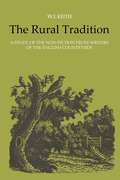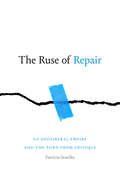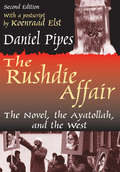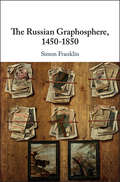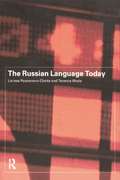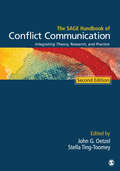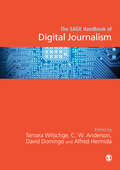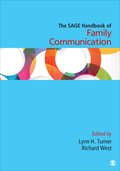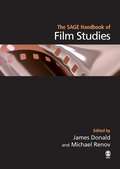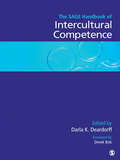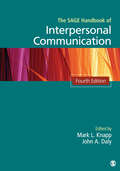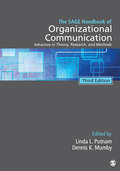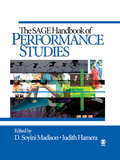- Table View
- List View
The Rural Gothic in American Popular Culture
by Bernice M. MurphyThe Rural Gothic in American Popular Culture argues that complex and often negative initial responses of early European settlers continue to influence American horror and gothic narratives to this day. The book undertakes a detailed analysis of key literary and filmic texts situated within consideration of specific contexts.
The Rural Tradition: A Study of the Non-Fiction Prose Writers of the English Countryside (The Royal Society of Canada Special Publications)
by William Keith'There is probably no single quality or characteristic – besides love of the countryside – that must inevitably distinguish a rural writer,' notes W.J. Keith. However, 'what distinguishes rural writing that belongs to literature from that belonging to natural history, agricultural history, etc., is, as Richard E. Haymaker has observed, the writer's "means of revealing Nature as well as describing her"...In the final analysis the rural essayist paints neither landscapes nor self-portraits; instead he communicates the subtle relationship between himself and his environment, offering for our inspection his own attitudes and his own vision. We may be asked to look or to agree, but more than anything else we are invited to share. Ultimately, then, the best rural writing may be said to provide us, in a phrase adapted from Robert Langbaum, with a prose of experience.' Keith argues that non-fiction rural prose should be recognized as a distinct literary tradition that merits serious critical attention. In this book he tests the cogency of thinking in terms of a 'rural tradition,' examines the critical problems inherent in such writing, and traces significant continuities between rural writers. Eleven of the more important and influential writers from the seventeenth century to modern times come under individual scrutiny: Izaak Walton, Gilbert White, William Cobbett, Mary Russell Mitford, George Borrow, Richard Jefferies, George Sturt/'George Bourne', W.H. Hudson, Edward Thomas Williamson, and H.J. Massingham.In examining these writers within the context of the rural tradition, Keith rescues their works from the literary attic where they have too often been relegated as awkward misfits. When studied together, each throws fascinating light on the others and is seen to fit into a loose but nonetheless discernible 'line.'
The Ruse of Repair: US Neoliberal Empire and the Turn from Critique
by Patricia StuelkeSince the 1990s, literary and queer studies scholars have eschewed Marxist and Foucauldian critique and hailed the reparative mode of criticism as a more humane and humble way of approaching literature and culture. The reparative turn has traveled far beyond the academy, influencing how people imagine justice, solidarity, and social change. In The Ruse of Repair, Patricia Stuelke locates the reparative turn's hidden history in the failed struggle against US empire and neoliberal capitalism in the 1970s and 1980s. She shows how feminist, antiracist, and anti-imperialist liberation movements' visions of connection across difference, practices of self care, and other reparative modes of artistic and cultural production have unintentionally reinforced forms of neoliberal governance. At the same time, the US government and military, universities, and other institutions have appropriated and depoliticized these same techniques to sidestep addressing structural racism and imperialism in more substantive ways. In tracing the reparative turn's complicated and fraught genealogy, Stuelke questions reparative criticism's efficacy in ways that will prompt critics to reevaluate their own reading practices.
The Ruse of Techne: Heidegger’s Magical Materialism (Perspectives in Continental Philosophy)
by Dimitris VardoulakisThe Ruse of Techne offers a reappraisal of Heidegger’s entire work by focusing on the forms of activity he regards as separate from instrumentality. Non-instrumental activities like authenticity, poetry, and thinking—in short, the ineffectual—are critical for Heidegger as they offer the only path to the truth of being throughout his work.By unearthing the source of the conception of non-instrumental action in Heidegger’s reading of Aristotle, Vardoulakis elaborates how it forms part of Heidegger’s response to an old problem, namely, how to account for difference after positing a single and unified being that is not amenable to change. He further demonstrates that an action without ends and effects leads to an ethics and politics rife with difficulties and contradictions that only become starker when compared to other responses to the same problem that we find in the philosophical tradition and which rely on instrumentality.Heidegger’s conception of an action without ends or effect forgets the role of instrumentality in the tradition that posits a single, unified being. And yet, the ineffectual has had a profound influence in how continental philosophy determines the ethical and the political since World War II. The critique of the ineffectual in Heidegger is thus effectively a critique of the conception of praxis in continental philosophy. Vardoulakis proposes that it is urgent to undo the forgetting of instrumentality if we are to conceive of a democratic politics and an ethics fit to respond to the challenges of high capitalism.
The Rushdie Affair: The Novel, the Ayatollah and the West
by Daniel PipesThe publication in 1988 of Salman Rushdie's novel The Satanic Verses triggered a furor that pitted much of the Islamic world against the West over issues of blasphemy and freedom of expression. The controversy soon took on the aspect of a confrontation of civilizations, provoking powerful emotions on a global level. It involved censorship, protests, riots, a break in diplomatic relations, culminating in the notorious Iranian edict calling for the death of the novelist. In The Rushdie Affair, Daniel Pipes explains why the publication of The Satanic Verses became a cataclysmic event with far-reaching political and social consequences.Pipes looks at the Rushdie affair in both its political and cultural aspects and shows in considerable detail what the fundamentalists perceived as so offensive in The Satanic Verses as against what Rushdie's novel actually said. Pipes explains how the book created a new crisis between Iran and the West at the time--disrupting international diplomacy, billions of dollars in trade, and prospects for the release of Western hostages in Lebanon.Pipes maps out the long-term implications of the crisis. If the Ayatollah so easily intimidated the West, can others do the same? Can millions of fundamentalist Muslims now living in the United States and Europe possibly be assimilated into a culture so alien to them? Insightful and brilliantly written, this volume provides a full understanding of one of the most significant events in recent years. Koenraad Elst's postscript reviews the enduring impact of the Rushdie affair.
The Rushdie Fatwa and After
by Brian WinstonThis resounding defence of the principles of free expression revisits the Satanic Verses uproar of 1989, as well as subsequent incidents such as the Danish cartoons controversy, to argue that the human right of free speech is by no means so secure that it can be taken for granted.
The Russian Folktale by Vladimir Yakovlevich Propp (Series in Fairy-Tale Studies)
by Jack Zipes Vladimir Yakovlevich Propp Sibelan E. S. ForresterVladimir Propp is the Russian folklore specialist most widely known outside Russia thanks to the impact of his 1928 book Morphology of the Folktale-but Morphology is only the first of Propp's contributions to scholarship. This volume translates into English for the first time his book The Russian Folktale, which was based on a seminar on Russian folktales that Propp taught at Leningrad State University late in his life. Edited and translated by Sibelan Forrester, this English edition contains Propp's own text and is supplemented by notes from his students. <p><p> The Russian Folktale begins with Propp's description of the folktale's aesthetic qualities and the history of the term; the history of folklore studies, first in Western Europe and then in Russia and the USSR; and the place of the folktale in the matrix of folk culture and folk oral creativity. The book presents Propp's key insight into the formulaic structure of Russian wonder tales (and less schematically than in Morphology, though in abbreviated form), and it devotes one chapter to each of the main types of Russian folktales: the wonder tale, the "novellistic" or everyday tale, the animal tale, and the cumulative tale. Even Propp's bibliography, included here, gives useful insight into the sources accessible to and used by Soviet scholars in the third quarter of the twentieth century. <p><p> Propp's scholarly authority and his human warmth both emerge from this well-balanced and carefully structured series of lectures. An accessible introduction to the Russian folktale, it will serve readers interested in folklore and fairy-tale studies in addition to Russian history and cultural studies.
The Russian Graphosphere, 1450-1850
by Simon FranklinThe 'graphosphere' is the dynamic space of visible words. Graphospheres mutate, they are reconfigured with changes in technology, in modes of production, in social structures, in fashion and taste. The graphospheric environment can be public or private, monumental or ephemeral. This book explores a new approach to the study of writing, with a focus on Russia during its 'long early modernity' from the late fifteenth century to the early nineteenth century. Taking an inclusive approach, it charts unmapped territory, uncovers sources that have almost entirely escaped attention and therefore provides, in the first instance, a unique reference guide to cultures of writing in Russia over four hundred years. Besides generating fresh insights into distinctive features of Russian culture, this outward-looking and accessible book offers a pioneering case study for the wider comparative exploration of the significance of technologies of the word.
The Russian Horizon: An Anthology (Routledge Library Editions: Russian and Soviet Literature #11)
by N. Gangulee, H. G. WellsThis book, first published in 1943, is a literary anthology purposefully presenting a picture of the Soviet Union to a new audience in the West. It collects together a rich variety of pre-revolutionary Russian literature as well as a host of Soviet literature. Together they reveal the dynamic character of Russian literature, and provide a useful contrast between the two styles of pre- and post-revolutionary writings.
The Russian Language Today
by Terence Wade Larissa Ryazanova-ClarkeThe Russian Language Today provides the most up-to-date analysis of the Russian language. The Russian language has changed dramatically in recent years, becoming inundated by new words, mainly from American English. The authors focus on the resulting radical changes in Russian vocabulary and grammar.Supported throughout by extracts from contemporary press and literary sources, this is a comprehensive overview of present-day Russian and an essential text for all students of the Russian language.
The SAGE Encyclopedia of Journalism: 2nd Edition
by Gregory A. BorchardJournalism permeates our lives and shapes our thoughts in ways that we have long taken for granted. Whether it is National Public Radio in the morning or the lead story on the Today show, the morning newspaper headlines, up-to-the-minute Internet news, grocery store tabloids, Time magazine in our mailbox, or the nightly news on television, journalism pervades our lives. The Encyclopedia of Journalism covers all significant dimensions of journalism, such as print, broadcast, and Internet journalism; U.S. and international perspectives; and history, technology, legal issues and court cases, ownership, and economics. The encyclopedia will consist of approximately 500 signed entries from scholars, experts, and journalists, under the direction of lead editor Gregory Borchard of University of Nevada, Las Vegas.
The SAGE Encyclopedia of Journalism: 2nd Edition
by Gregory A. BorchardJournalism permeates our lives and shapes our thoughts in ways that we have long taken for granted. Whether it is National Public Radio in the morning or the lead story on the Today show, the morning newspaper headlines, up-to-the-minute Internet news, grocery store tabloids, Time magazine in our mailbox, or the nightly news on television, journalism pervades our lives. The Encyclopedia of Journalism covers all significant dimensions of journalism, such as print, broadcast, and Internet journalism; U.S. and international perspectives; and history, technology, legal issues and court cases, ownership, and economics. The encyclopedia will consist of approximately 500 signed entries from scholars, experts, and journalists, under the direction of lead editor Gregory Borchard of University of Nevada, Las Vegas.
The SAGE Handbook of Child Development, Multiculturalism, and Media
by Joy K. Asamen Mesha L. Ellis Gordon L. BerryThe SAGE Handbook of Child Development explores the multicultural development of children through the varied and complex interplay of traditional agents of socialization as well as contemporary media influences, examining how socialization practices and media content construct and teach us about diverse cultures. Editors Joy K. Asamen, Mesha L. Ellis, and Gordon L. Berry, along with chapter authors from a wide variety of disciplines, highlight how to analyze, compare, and contrast alternative perspectives of children of different cultures, domestically and globally, with the major principles and theories of child development in cognitive, socioemotional, and/or social/contextual domains.
The SAGE Handbook of Conflict Communication: Integrating Theory, Research, and Practice
by John G. Oetzel and Stella Ting-ToomeyThis second edition of the award-winning The SAGE Handbook of Conflict Communication emphasizes constructive conflict management from a communication perspective, identifying the message as the focus of conflict research and practice. Editors John G. Oetzel and Stella Ting-Toomey, along with expert researchers in the discipline, have assembled in one resource the knowledge base of the field of conflict communication; identified the best theories, ideas, and practices of conflict communication; and provided the opportunity for scholars and practitioners to link theoretical frameworks and application tools. Fully updated with the latest research throughout, the second edition offers new chapters on qualitative and quantitative research methods for conflict, intimate partner violence, family dynamics, mental health, negotiation, workplace bullying, healthcare conflict, identity and intercultural conflict, the middle way approach, conflict in the global workplace, the culture-based situational conflict model, community ethics and engagement, spirituality and conflict, and trust in academic-community partnerships.
The SAGE Handbook of Digital Journalism
by David Domingo Alfred Hermida Tamara Witschge Chris W. AndersonThe production and consumption of news in the digital era is blurring the boundaries between professionals, citizens and activists. Actors producing information are multiplying, but still media companies hold central position. Journalism research faces important challenges to capture, examine, and understand the current news environment. The SAGE Handbook of Digital Journalism starts from the pressing need for a thorough and bold debate to redefine the assumptions of research in the changing field of journalism. The 38 chapters, written by a team of global experts, are organised into four key areas: Section A: Changing Contexts Section B: News Practices in the Digital Era Section C: Conceptualizations of Journalism Section D: Research Strategies By addressing both institutional and non-institutional news production and providing ample attention to the question ‘who is a journalist?’ and the changing practices of news audiences in the digital era, this Handbook shapes the field and defines the roadmap for the research challenges that scholars will face in the coming decades.
The SAGE Handbook of Digital Journalism
by David Domingo Alfred Hermida Tamara Witschge Chris W. AndersonThe production and consumption of news in the digital era is blurring the boundaries between professionals, citizens and activists. Actors producing information are multiplying, but still media companies hold central position. Journalism research faces important challenges to capture, examine, and understand the current news environment. The SAGE Handbook of Digital Journalism starts from the pressing need for a thorough and bold debate to redefine the assumptions of research in the changing field of journalism. The 38 chapters, written by a team of global experts, are organised into four key areas: Section A: Changing Contexts Section B: News Practices in the Digital Era Section C: Conceptualizations of Journalism Section D: Research Strategies By addressing both institutional and non-institutional news production and providing ample attention to the question 'who is a journalist?' and the changing practices of news audiences in the digital era, this Handbook shapes the field and defines the roadmap for the research challenges that scholars will face in the coming decades.
The SAGE Handbook of Family Communication
by Dr Lynn H Turner Richard L. WestA thorough exploration of the critical topics and issues facing family communication researchers today The Sage Handbook of Family Communication provides a comprehensive examination of family communication theory and research. Chapters by leading scholars in family communication expand the definition of family, address recent shifts in culture, and cover important new topics, including families in crisis, families and governmental policies, social media, and extended families. The combination of groundbreaking theories, research methods, and reviews of foundational and emerging research in family communication make this an invaluable resource that explores the critical topics and issues facing family communication researchers today.
The SAGE Handbook of Family Communication
by Dr Lynn H Turner Richard L. WestA thorough exploration of the critical topics and issues facing family communication researchers today The Sage Handbook of Family Communication provides a comprehensive examination of family communication theory and research. Chapters by leading scholars in family communication expand the definition of family, address recent shifts in culture, and cover important new topics, including families in crisis, families and governmental policies, social media, and extended families. The combination of groundbreaking theories, research methods, and reviews of foundational and emerging research in family communication make this an invaluable resource that explores the critical topics and issues facing family communication researchers today.
The SAGE Handbook of Film Studies
by Michael Renov Dr James DonaldWritten by a team of veteran scholars and exciting emerging talents, The SAGE Handbook of Film Studies maps the field internationally, drawing out regional differences in the way that systematic intellectual reflection on cinema and film has been translated into an academic discipline. It examines the conversations between Film Studies and its contributory disciplines that not only defined a new field of discourse but also modified existing scholarly traditions. It reflects on the field's dominant paradigms and debates and evaluates their continuing salience. Finally, it looks forward optimistically to the future of the medium of film, the institution of cinema and the discipline of Film Studies at a time when the very existence of film and cinema are being called into question by new technological, industrial and aesthetic developments.
The SAGE Handbook of Intercultural Competence
by Darla K. DeardorffBringing together leading experts and scholars from around the world, this Handbook provides a comprehensive overview of the latest theories and research on intercultural competence. It will be a useful and invaluable resource to administrators, faculty, researchers, and students.
The SAGE Handbook of Interpersonal Communication
by John A. Daly Professor Mark L. KnappThe revised Fourth Edition of The SAGE Handbook of Interpersonal Communication delivers a clear, comprehensive, and exciting overview of the field of interpersonal communication. It offers graduate students and faculty an important, state-of-the-art reference work in which well-known experts summarize theory and current research. The editors also explore key issues in the field, including personal relationships, computer-mediated communication, language, personality, skills, nonverbal communication, and communication across a person's life span. This updated handbook covers a wide range of established and emerging topics, including: Biological and Physiological Processes Qualitative and Quantitative Methods for Studying Interpersonal Communication Interpersonal Communication in Work, Family, Intercultural, and Health Contexts Supportive and Divisive Transactions Social NetworksEditors Mark L. Knapp and John A. Daly have significantly contributed to the field of interpersonal communication with this important reference work—a must-have for students and scholars.
The SAGE Handbook of Media Processes and Effects
by Mary Beth Oliver Robin L. NabiThe study of media processes and effects is one of the most central to the discipline of communication and encompasses a vast array of theoretical perspectives, methodological tools, and applications to important social contexts. In light of this importance—as well as the rapid changes in the media environment that have occurred during the past 20 years—this Handbook explores where media effects research has been over the past several decades, and, equally important, contemplates where it should go in the years ahead. COVERAGE Part I offers an overview of the field and conceptualizations of media effects, along with a range of quantitative and qualitative methodologies used in the study of media effects. Part II focuses on prominent theoretical approaches to the study of media effects from a more societal perspective, tracing their historical contexts, theoretical developments, criticisms and controversies, and the impact of the new media environment on current and future research. Part III emphasizes the various factors that influence the critical functions of message selection and processing central to a host of mass media application contexts. Part IV reflects a dominant trend in the media effects literature—that of persuasion and learning—and traces related theoretical perspectives through the various contexts in which media may have such effects. Part V explores the contexts and audiences that have been traditional foci of media effects research, such as children, violence, body image, and race, addressing the theories most applicable to those contexts. Part VI highlights a concern central and unique to the communication discipline—message medium—and how it influences effects ranging from what messages are attended to, how we spend our time, and even how we think.
The SAGE Handbook of Nonverbal Communication
by Dr Valerie L. Manusov Miles L. PattersonThis Handbook provides an up-to-date discussion of the central issues in nonverbal communication and examines the research that informs these issues. Editors Valerie Manusov and Miles Patterson bring together preeminent scholars, from a range of disciplines, to reveal the strength of nonverbal behavior as an integral part of communication.
The SAGE Handbook of Organizational Communication: Advances in Theory, Research, and Methods
by Linda L. Putnam Dennis K. MumbyOrganizational communication as a field of study has grown tremendously over the past thirty years. This growth is characterized by the development and application of communication perspectives to research on complex organizations in rapidly changing environments. Completely re-conceptualized, The SAGE Handbook of Organizational Communication, Third Edition, is a landmark volume that weaves together the various threads of this interdisciplinary area of scholarship. This edition captures both the changing nature of the field, with its explosion of theoretical perspectives and research agendas, and the transformations that have occurred in organizational life with the emergence of new forms of work, globalization processes, and changing organizational forms. Exploring organizations as complex and dynamic, the Handbook brings a communication lens to bear on multiple organizing processes.
The SAGE Handbook of Performance Studies
by Dr D. Soyini Madison Judith A. HameraThe SAGE Handbook of Performance Studies brings together, in a single volume, reviews of the major research in performance studies and identifies directions for further investigation. It is the only comprehensive collection on the theories, methods, politics, and practices of performance relating to life and culture. Edited by D. Soyini Madison and Judith Hamera, this Handbook serves scholars and students across the disciplines by delineating the scope of the field, the critical and interpretive methods used, and the theoretical and ethical presumptions that guide work in this exciting and growing area.

